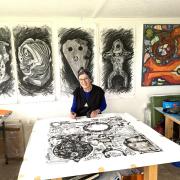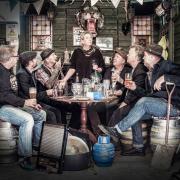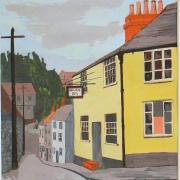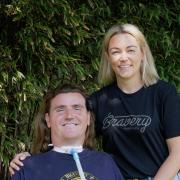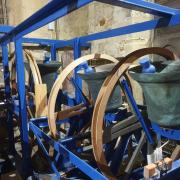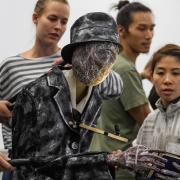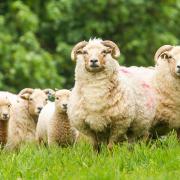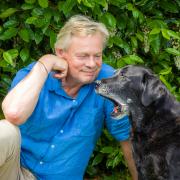Many husbands, fathers, fiances and sons going to war had their photograph taken in uniform. These poignant mementoes can provide vital clues about the role your ancestor had during the Great War

During the First World War, commercial photographers were in increasing demand for studio portraits as uniformed men flocked to have their photograph taken as a memento for their loved ones. Images of soldiers and sailors posing before elaborately painted canvases were produced in their hundreds of thousands.
Sherborne Museum’s photographic archive boasts a fine collection of these First World War studio portraits, which are believed to have been taken by local photographer, Adam Gosney (1844-1921). The following photographs from this archive, show how analysis of the badges and insignia can provide interesting clues as to the identity of the individuals shown.
***
The Eason Brothers (above)
This photograph of four brothers from Sherborne provides an interesting contrast between the different uniforms and insignia worn by officers and ‘other ranks’. The officer seated front left, whose cap badge shows that he served with the Nottinghamshire and Derbyshire Regiment, is wearing Officers’ Service Dress. The brown-leather Sam Browne belt was not usually worn in the field after 1914 but continued to be used by commissioned officers at home. The ‘facing’ pairs of distinctive collar badges were usually bronzed. Officers wore their rank insignia on their cuffs. However, this also made them conspicuous to enemy snipers, so many officers took to wearing their rank badges on their shoulders instead. This may explain why the two officers here have plain cuffs. The serviceman standing on the right wears the distinctive uniform and cap badge of the Royal Naval Air Service. This consisted of a double-breasted jacket with a roll-step collar (the so-called ‘monkey jacket’), worn over a white shirt with soft collar and black tie.

***
Saddler-Sergeant of the Queen’s Own Dorset Yeomanry
The presence of riding crops indicates that these brothers belonged to cavalry regiments. The solider standing wears the cap badge of the Queen’s Own Dorset Yeomanry. On his upper right arm the sleeve rank indicates three stripes for a sergeant, and above this is a proficiency badge for a saddler. His brother, seated, wears the cap badge of the 3rd (King’s Own) Hussars, confirmed by the brass shoulder title on the epaulette. Over his left shoulder he wears a white lanyard – a long piece of cord used to secure a jack-knife. Issued to both cavalry and artillery regiments, this was useful for cutting loose horses which had become entangled, or for the removal of stones from hooves. For artillerymen a fuse key would also be attached to the end of the lanyard.
***

Stoker 1st Class in the Royal Navy
It was common for seamen to be photographed with their cap band (known as a tally) prominently displayed, as it featured the name of the ship or establishment to which the sailor belonged. This sailor was serving in H.M.S. Glorious. On his upper right sleeve is the trade badge of a Stoker 1st Class (a three-bladed propeller with star above). Once he had risen higher in rank he would wear a rating badge on his upper left sleeve to signify his advanced position (for example, a fouled anchor for a leading seaman). The inverted chevrons shown on his lower left sleeve are his sea service chevrons. These were first authorised in May 1918, and were awarded to denote service overseas from 4th August 1914. Each chevron was awarded on a calendar year basis; three months’ qualifying service in that calendar year entitled him to the award. Interestingly, this sailor appears to have sewn his chevrons onto the wrong sleeve, as they should be placed on the right arm!
***
Convalescent soldiers in their ‘Hospital Blues’

This photograph shows two servicemen in their blue hospital suits, presumably taken while convalescing in Sherborne. Special uniforms were issued to all wounded soldiers who had been sent back home to recover. It consisted of a blue single-breasted jacket with white lining (worn open at the neck), blue trousers, a white shirt and a red woven tie. Soldiers also wore their Service Dress cap with regimental badge, which, in the absence of other insignia, can be a vital clue for identifying an individual. Where no cap was available, soldiers usually pinned their regimental badge onto their lapel. The need to ensure that convalescing soldiers had a uniform they could wear in public became especially important during the First World War. It not only showed that the man was in the armed services, but that he had served overseas and been wounded in action.
***
Soldier of the Dorsetshire Regiment (main image)
The cap badge tells us that this is a soldier of the Dorsetshire Regiment. On his lower left sleeve is the proficiency badge of a Lewis gunner (the initials “L.G.” surrounded by a laurel wreath). Badges were worn in different places depending upon their significance. Those for an instructor, for example, were worn on the upper right arm, whereas skill-at-arms and trade badges were worn on the lower left arm. Below his proficiency badge can be seen a wound stripe. First authorised in August 1916, they were worn vertically on the lower left sleeve. Each stripe denoted the receipt of a wound sustained in action since 4th August 1914, the term “wounded” referred to those whose names had appeared in the official casualty lists as “wounded”. Subsequent stripes were placed either side of the original, and many soldiers had several. On his left breast is a medal ribbon for the Military Medal. This award was established in March 1916, but could be back-dated to the outbreak of the war.
--------------------------------------------------
About Luke Mouland - Luke is a professional geneaologist and historian. He runs the website Kith and Kin from his home near Sherborne (kithandkinresearch.co.uk)
--------------------------------------------------
Read on
• Where to start when tracing relatives and the meaning behind some Dorset surnames




